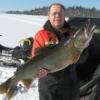I'm sure there's nothing to worry about Dave.
Fuel bundles, when discharged from CANDU reactors, are highly radioactive and are generating significant amounts of heat from radioactive decay. (In the sketch, 10E16 means 10 to the 16th power, i.e., 10 x 10 16 times.) The radioactivity is due essentially to two sources, the fission products and the transuranics (plutonium and other elements heavier than uranium that have been produced in the reactor from the capture of neutrons by uranium atoms). Because of differences in the natures of these two groups, two different approaches are needed to protect against the radioactive hazards that they present:
The bulk of the fission products, including those causing most concern, are very highly radioactive. They must therefore be surrounded by shielding to absorb the radiation that they emit for the period that the radiation is strong enough to be harmful. Since their intense radioactivity is due to their relatively short half-lives, e.g., cesium-137 with 30 years, it decreases rapidly.
After about ten half-lives of the fission products, i.e., several hundred years, the radioactivity is dominated by the transuranics which have very long half-lives, e.g., plutonium-239 with 24,000 years, and hence very low specific activity. The property most relevant to health is that their radioactivity is by emission of alpha-particles (Chapter 2) which have only a very short range in matter, so that they must be prevented from entering the human body, by inhalation or ingestion.*
And its not like it could ever leak. History has proven we know how to handle this stuff, right?
http://www.cbc.ca/news/technology/story/2013/08/23/fukushima-water.html
Of course the problem is, the cat is sort of out of the bag now, so to speak ?
*Quote From J.A.L Robinson - Decide The Nuclear Issues for yourself.





